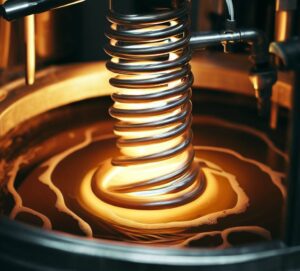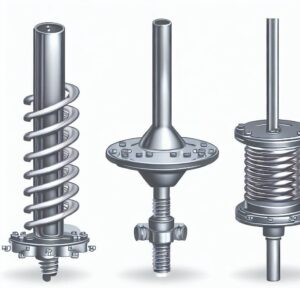Table of Contents
Selecting the right heater is essential for efficient heat and long service life. Various factors need to be taken into account, such as the application type, required temperature, sheath material, and watt density.
To choose the right heater, it’s important to know what it will be used for. Different heaters are made for specific tasks, like heating water in tanks or plating solutions. Knowing your needs will help find the right one.
The sheath material plays a big role in the performance and durability of the heater. Materials like stainless steel, copper, and incoloy resist corrosion and high temperatures well. Choosing the right sheath material ensures it is compatible with the process or chemicals.

Watt density is also important. It is the amount of power per unit area applied by the heating element. Too much wattage density can cause burnout or pinholes in certain solutions or materials. Too little wattage density may not provide enough heat transfer for faster heating.
Did you know? Screw plug immersion heaters are more flexible and easier to install than flange heaters because of their compact size and direct contact with the liquid.
Key Notes
- 1. Determine your heating needs: Before choosing an immersion heater, it is important to assess your heating requirements. Consider factors such as the volume of water to be heated, the desired temperature, and the time it will take to heat the water.
- 2. Consider the type of immersion heater: There are different types of immersion heaters available, including screw plug, flanged, and overtheside heaters. Each type has its own advantages and is suitable for specific applications. Understanding the differences between these types will help you make an informed decision.
- 3. Material compatibility: Immersion heaters come in various materials, such as stainless steel, titanium, and Incoloy. It is crucial to choose a material that is compatible with the liquid being heated to avoid corrosion or contamination. Consider factors like acidity, alkalinity, and chemical composition when selecting the material.
- 4. Watt density: Watt density refers to the amount of power output per square inch of the heating element. It is important to choose an immersion heater with an appropriate watt density for your application. High watt density heaters are suitable for quick heating, while low watt density heaters are better for gradual heating and preventing overheating.
- 5. Safety features: Look for immersion heaters that have builtin safety features such as temperature control, overheat protection, and automatic shutoff. These features can help prevent accidents and ensure the longevity of the heater.
- 6. Energy efficiency: Consider the energy efficiency of the immersion heater. Look for heaters with insulation or efficient heat transfer mechanisms to minimize heat loss and reduce energy consumption.
- 7. Installation and maintenance: Consider the ease of installation and maintenance when choosing an immersion heater. Look for heaters that are easy to install and have accessible components for maintenance and repairs.
- 8. Cost: While cost should not be the sole determining factor, it is important to consider the price of the immersion heater and its longterm value. Compare prices from different manufacturers and consider the overall quality and durability of the heater.
- 9. Seek professional advice: If you are unsure about which immersion heater to choose, it is always a good idea to seek advice from a professional or consult with a reputable supplier. They can provide guidance based on your specific requirements and help you make an informed decision.
Factors to Consider to choose Immersion Heater
When selecting an immersion heater, there are several factors to keep in mind for optimal performance and efficiency. For instance, consider the heater type and sheath material. The watt density and installation requirements must also be taken into account. And, don’t forget the safety features such as temperature control and overheat protection.
Other important factors include the heater’s service life, energy efficiency ratings, manufacturer reputation, cost, and any customizations needed.
Finding the perfect immersion heater is essential for reliable heat transfer and successful productivity. So, take the time to assess your needs and consult industry experts or manufacturers. You’ll be sure to find the perfect solution for your application!
Types of Immersion Heaters
When it comes to immersion heaters, there are various types to choose from. The table below outlines the key features and applications of different types.
| Type | Key Features | Applications |
|---|---|---|
| Screw Plug | Easily installed in tanks | Hot water tanks |
| Flange | Ideal for heating liquids | Large industrial |
| Over-The-Side (Side) | Easy to maintain and replace heating element | Open tanks or containers |
To select the best heater, you must also look into the sheath material, watt density, power density, wattage, installation, and environmental conditions. Get expert guidance or consult manufacturers to help you make an informed decision.

Finding the right immersion heater is essential – it must be hot, reliable, and not leave you out in the cold!
Choosing the Right Immersion Heater
Selecting an appropriate heater can appear difficult. But, with the vast range of immersion heaters available, there’s sure to be one that fits your needs! When selecting, take note of the type of heating element and sheath material, watt density, and the purpose.
To make this process easier, here’s a quick overview of the key considerations when selecting an immersion heater:
- Heating Element: Screw plug or side-mounted. The screw plug is versatile and used for heating water, oil, or chemicals. Side-mounted is great for tight spaces and gives even heat distribution.
- Sheath Material: Stainless steel, copper, or Incoloy. Steel is corrosion-resistant and good for water and mild corrosives. Copper has great thermal conductivity and used in brewing. Incoloy resists high temp and corrosives.
- Watt Density: Power output per inch of heated area. Choose the right watt density to prevent overheating or damage to the heater. Low watt is good for viscous materials or fluids.
- Application: Specialized heaters may be needed for certain industries. For instance, chemical industries may need explosion-proof sheathed heaters.
- Pro Tip: Consult manufacturers when deciding which heater to choose based on your requirements and fluid type.

Don’t let selecting the right immersion heater give you a fright, just remember to consider the heating element type, sheath material, watt density, and application for optimal performance, longevity, and efficiency!
Frequently Asked Questions
1. What factors should I consider when choosing an immersion heater?
Answer: When choosing an immersion heater, consider factors such as the desired temperature, heating element type, sheath material, watt density, and application requirements.
2. What are the different types of immersion heaters available?
Answer: There are various types of immersion heaters, including screw plug immersion heaters, flange immersion heaters, and side immersion heaters. Each type is suitable for different applications and tank configurations.
3. What is the importance of sheath material in an immersion heater?
Answer: The sheath material is crucial as it determines the heater’s resistance to corrosion, heat transfer efficiency, and compatibility with different fluids or chemicals. Popular sheath materials include stainless steel, Incoloy, and copper.
4. How does watt density affect immersion heater performance?
Answer: Watt density refers to the amount of power per square inch of the heater’s surface area. Choosing the appropriate watt density is crucial to prevent overheating, ensure a longer service life, and maintain optimal heat transfer.
5. What are the advantages of using a screw plug immersion heater?
Answer: Screw plug immersion heaters are versatile and easy to install, making them suitable for various applications. They also allow direct contact with liquids and offer efficient heat transfer.
6. What are the key considerations when selecting an immersion heater for the chemical industry?
Answer: In the chemical industry, it is important to choose an immersion heater that can withstand corrosive chemical solutions. Stainless steel sheath materials and low watt density heaters are commonly used for this purpose.
Conclusion: Providing a summary of key points and offering final tips for selecting the best immersion heater
Choosing the right immersion heater is vital for efficient heating. Look at things like sheath material, watt density, and installation type. Pick a heater that matches the application to make sure it’s safe and lasts long.
Various types of immersion heaters exist, such as screw plug and side ones. The selection relies on factors like the heating medium, tank size, and temperature needs. Screw plug heaters are often used in open tanks, while side immersion heaters work well for heavy-duty applications.
Sheath materials like stainless steel, incoloy, and copper offer various levels of corrosion resistance. Select the most suitable material based on the chemical solutions or fluids that need heating. Assess the watt density of the heater element to avoid overheating and stay efficient.
When installing, guarantee proper contact between the heater element and heating medium for effective heat transfer. If necessary, use circulation systems to disperse heat around the tank or container.
